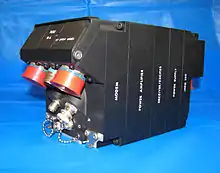
The ARC-210 is a family of radios for military aircraft that provides two-way, multi-mode voice and data communications over a 30 to 512+ MHz frequency range. It covers both Ultra High Frequency (UHF) and Very High Frequency (VHF) bands with AM, FM and SATCOM capabilities.[1] The ARC-210 radio also includes embedded anti-jam waveforms, including Havequick and SINCGARS, and other data link and secure communications features, providing total battlefield interoperability and high-performance capabilities in the transfer of data, voice and imagery. It features a separate guard receiver for monitoring 121.5 and 243 MHz while simultaneously monitoring the active channel selected. Transmitter power ranges from 5 to 23 watts, depending on frequency and mode. The radios communicates with other avionics over a MIL-STD-1553 data bus.
The ARC-210s are manufactured by Rockwell Collins and are installed in a wide range of aircraft, helicopters and ships across all five U.S. military services. The ARC-210 program began in 1990 as an improved version of the AN/ARC-182, adding jam-reisistant SINCGARS capability to communicate with Army radios for close air support.[2] The Arc-210 is installed on more than 180 platforms and is operating in more than 40 countries. As of 2010, 30,000 have been produced[3] and by October 2016, 40,000 delivered.[4] The radios have generated over $2 billion in sales for the company.[5]
There are six generations of the radios.[6] Models include the RT-1556, RT-1794, RT-1824, RT-1851, RT-1851A, and RT-1939, RT-1939A, RT-1990, RT-1990A and the RT-2036. The earliest model covered 30-400 MHz. The fifth generation RT-1939 is one of the first military radios to have software-programmable encryption under the National Security Agency’s (NSA) Cryptographic Modernization Initiative.[7] Its frequency range is extended and includes the following bands:
- VHF 30-88 MHz close air support
- VHF 108-118 MHz navigation
- VHF 118-137 MHz air traffic control
- VHF 137-156 MHz land mobile
- VHF 156-174 MHz maritime
- UHF 225-512 MHz military/homeland defense
- UHF 806-824, 851-869, 869-902, 935-941 MHz public safety bands
Continuous Tone-Coded Squelch System (CTCSS), used by many public safety agencies, is available above 400 MHz and below 88 MHz.[6]
The transceiver weighs about 12.2 lb (5.53 kg). Available accessories include remote controls, transmit power amplifiers, receive low-noise amplifiers, and ground support equipment.
See also
- AN/ARC-231, similar radio produced by Raytheon
- List of military electronics of the United States
References
- ↑ "AN/ARC-210 Gen5 Programmable Digital Communication System". Collins Aerospace.
- ↑ Philip J. Klass (4 June 1990). "Two New Jam-Resistant Sicgars Radios Readied for Flight Tests". Aviation Week. pp. 79–81.
Collins new ARC-210 UHF/VHF radio … is an improved version of the company's ARC-182. The new radio is designed to add Sincgars capability to communicate with the Army for close air support, as well as Have Quick-2 for Air Force compatibility.
- ↑ "NAVAIR accepts 30,000th ARC-210 radio | NAVAIR - U.S. Navy Naval Air Systems Command - Navy and Marine Corps Aviation Research, Development, Acquisition, Test and Evaluation". Archived from the original on 4 March 2016. Retrieved 1 March 2013.
- ↑ "Rockwell Collins delivers 40,000th ARC-210 radio to U.S. military". Retrieved 7 December 2016.
- ↑ "Rockwell Collins delivers 30,000th ARC-210 radio to U.S. military" (Press release). Rockwell Collins. 28 April 2010. Archived from the original on 22 August 2014.
- 1 2 "ARC-210 Program Overview for the 2011 CNS/ATM Conference" (PDF). Archived from the original (PDF) on 4 March 2016. Retrieved 19 September 2022.
- ↑ John Keller (17 September 2021). "Navy orders more than 8,000 AN/ARC-210(v) avionics radios from Collins Aerospace for aviation communications". Military Aerospace Electronics.